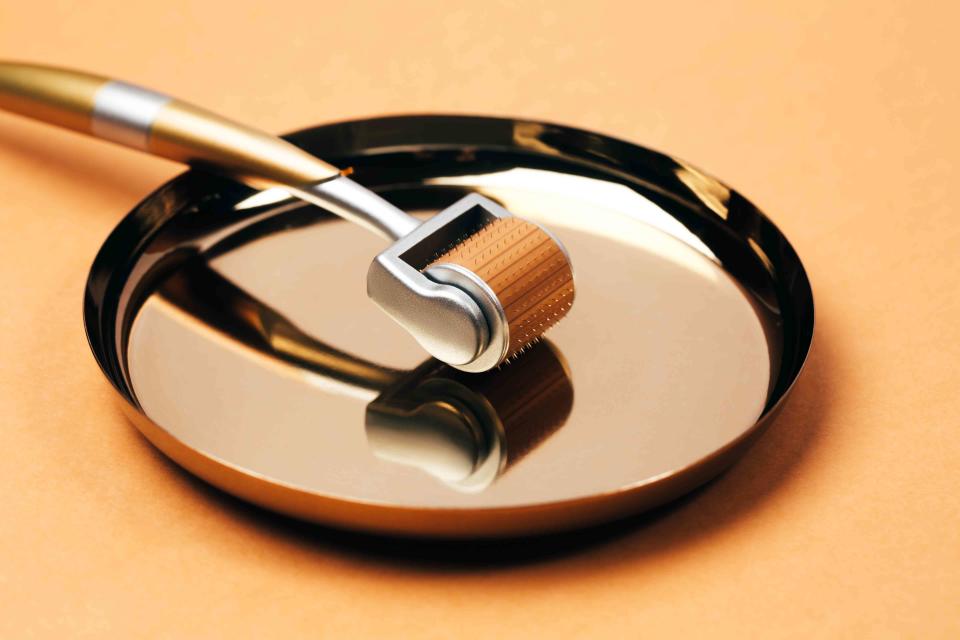Everything You Need to Know About RF Microneedling for Skin
Aesthetic dermatologists give the rundown on RF microneedling treatments.

Anna Efetova/Getty Images
The world of aesthetic dermatology is ever-evolving and expanding with new technologies and treatment types that address a whole host of skincare concerns. Microneedling—which involves creating controlled micro-tears in the skin to spur elastin and collagen production—is a procedure that’s been around for a while, but the addition of RF (short for radiofrequency) has taken the treatment to the next level.
Ahead, we’re diving into what RF microneedling is, what skincare concerns this in-office treatment can target, and what you can expect in terms of realistic results. We’re also covering RF microneedling cost, recovery, ideal candidates, and what it feels like to have the treatment done.
What Is RF Microneedling?
RF microneedling is an in-office procedure with minimal downtime that combines two modalities into one treatment: radiofrequency and microneedling.
“Radiofrequency [heats the skin to] stimulate collagen and elastin production, which lifts and tightens. Meanwhile, the microneedling portion resurfaces the skin improving overall texture,” explains aesthetics expert Adrienne O’Connell, DO, founder and medical director of Laguna Beach Aesthetics. “This is a great combination as it improves fine lines, wrinkles, and pore size all while tightening and lifting the skin.”
These RF microneedling treatments—which include Vivace RF, Morpheus8, and VirtueRF among others—fuse both of these approaches into one singular device to cut down on your treatment time and enhance overall results.
What Does RF Microneedling Treat?
The goal of RF microneedling is to trigger your body's wound-healing response while also stimulating new collagen and elastin production, explains Carmen Castilla, MD, a board-certified dermatologist at New York Dermatology Group. This dual-treatment approach offers numerous anti-aging results, including:
Skin tightening
Reduction of crepey skin
Fewer fine lines and wrinkles
Minimization of acne scars
Smaller looking pores
Improved tone and texture
Ideal Candidates for RF Microneedling
Those hoping to mildly smooth, tighten, lift, and improve overall skin texture are good candidates for RF microneedling. It’s a powerful treatment and many people do enjoy their results. However, Dr. Castilla notes that results are subtle—perhaps eliciting more of a “You look like you've been sleeping well!” sort of compliment—rather than a completely transformative face lift or other sort of invasive surgery.
“Anyone with severe laxity or deep wrinkles that is expecting significant improvement is likely to be disappointed from any of these devices,” she notes. “[I recommend] a consultation with a board-certified dermatologist or plastic surgeon to have an idea if this type of device is the right treatment option for what you are trying to improve.”
Those who shouldn’t get the treatment include people who are pregnant or breastfeeding, those with an active infection or ongoing acne breakouts, and people dealing with rashes or other skin irritations. Also, Dr. Castilla adds that treating darker skin tones with these devices requires advanced expertise, so ensure that the person treating you has experience working with darker skin tones.
RF Microneedling Cost
The cost of RF microneedling depends on the size of the area being treated and the number of sessions required. Generally speaking, you can expect to pay between $500 and $2000 per session.
A portion of your face would be closer to the lower end of this range, while treating your full face may cost closer to $1000. The higher end includes treating additional areas, such as your neck, chest, and decolletage.
“Typically, a series of treatments are needed to see any results—on average three spaced one month apart,” Dr. Castilla says. Dr. O’Connell says this is true of her practice, as well, noting that she often requires three to five sessions spaced out every four weeks.
What RF Microneedling Feels Like
Given the nature of RF microneedling, you probably won’t be surprised to hear that it’s not the most pleasurable experience. However, it is much less invasive than surgery and there are other in-office treatment modalities that are just as, or more, uncomfortable. Also, your provider will almost always apply a numbing cream to your face beforehand (similar to being numbed at the dentist before having certain work done).
RF microneedling feels like a prickling sensation paired with heat, which feels more intense in some areas of treatment compared to others. It also tends to get a little more intense as the treatment session progresses, particularly if numerous passes over the same area are being made.
“The nice thing is that downtime is very minimal. It includes some mild redness and swelling that usually resolves in less than 24 hours,” notes Dr. O’Connell. “I tell my patients that the channels we create with the microneedling stay open for six hours, so I don’t want them to put anything on their face for six hours, and then if they want to wash with a gentle cleanser and apply a moisturizer.”
How Long Does It Take to See RF Microneedling Results?
While there is a temporary glow and tightening effect caused by mild swelling post-procedure, you will not see immediate results with RF microneedling. This is because the treatment works by triggering your body’s wound-healing response and production of elastin and collagen, which can take weeks and months. Optimal results are usually seen within three to six months.
For more Real Simple news, make sure to sign up for our newsletter!
Read the original article on Real Simple.

